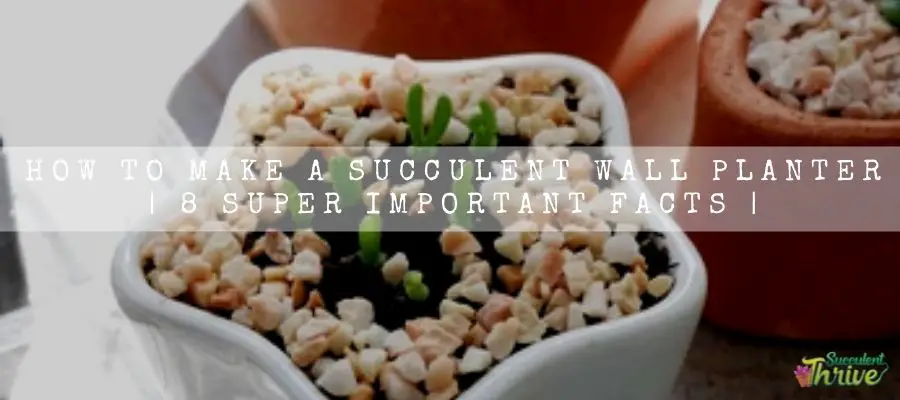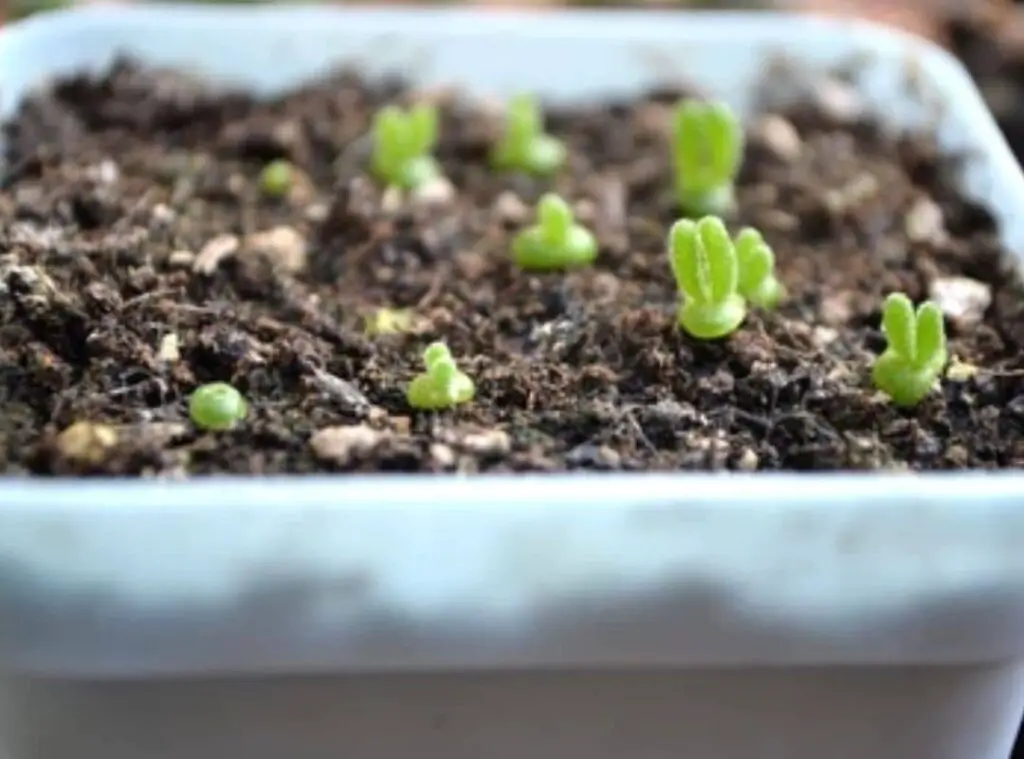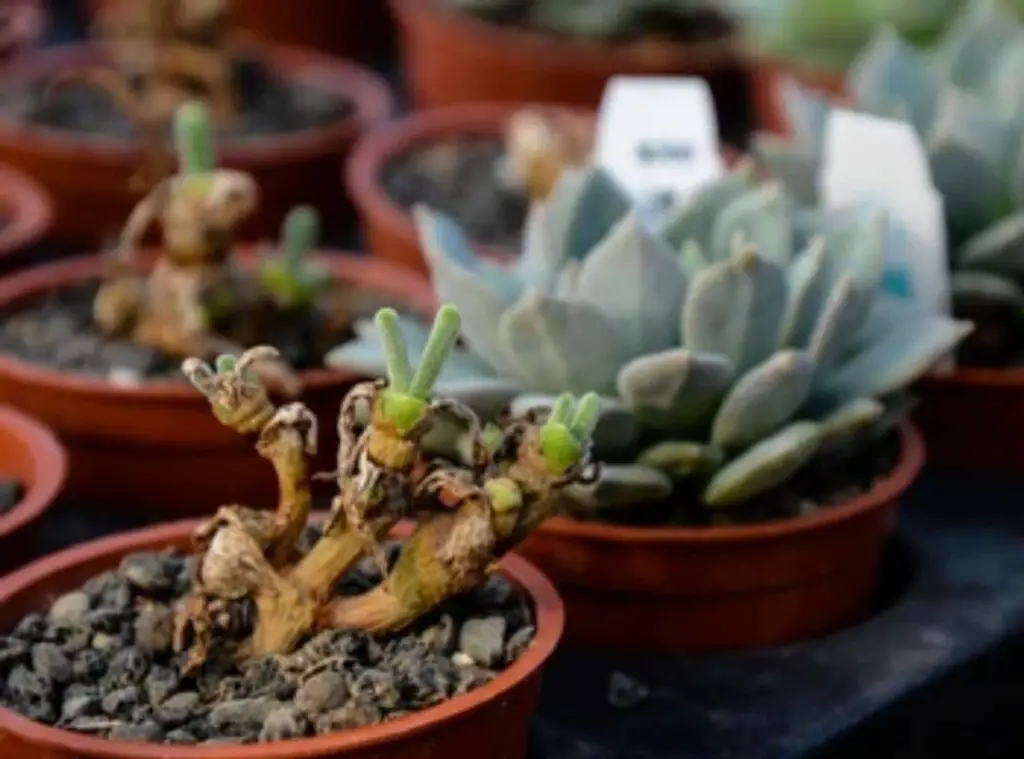Monilaria obconica is one of the cutest plants in the succulent world. In fact they look like a small bunny head with green ears. Although they are super cute you have to give a little bit of extra attention to these plants.
In this article I am going to explain how to take care of bunny succulents and its propagation methods.

What is Monilaria obconica?
Monilaria obconica commonly known as bunny succulents. They are native plants in Namaqualand, South Africa.
They generally grow on little mountains. The leaves of the bunny succulents conserve water.
Bunny succulent is a tiny succulent which forms in clumps. Furthermore, it is a seasonal deciduous plant too.
This plant consists of both leaves and stems. They belong to the family Mesembryanthemaceae (Aizoaceae).
They look so cute with their attractive ear shaped leaves, however those ears won’t remain the same. As the plant grows, their ears will get longer and taller.
When this happens, they will resemble string beans. Still, many people love to grow one of these succulents due to their attractiveness.
Chances are that the bunny succulent will ultimately blossom with rose colored flowers.
Bunny Succulent, Bunny Ear Succulent, are a couple of the common names which you could use to call these plants. They have inherited these names mainly due to their bunny ear looks.
How do I identify a Monilaria obconica
You could identify a bunny succulent simply by looking at its stems and leaves. Stems of Monilaria obconica will have shorter branches along with a beaded structure.
Moreover their leaves will look like spaghetti. They will initially be green in color. Ultimately, they will turn red in color once we expose them to sunlight.
Bunny Succulents have epidermis which consist of little shiny pearls. They are special because they can store water in their cells.
These cells could store the moisture for weeks even when we separate them and place them in a dry environment.
In addition to this, one more interesting fact on the bunny succulents is that they usually have leaf formations in two different ways.
The leaves which they make during the beginning of their dormancy will be compact.
On the other hand, when they grow to their fullest potential, they will form leaves which would work like a defensive sheath to its stem.
Apart from all these, they form some attractive rose flowers too.
Size of the plant
Bunny succulent is a tiny succulent. It could grow up to 6 to 8 inches in height only.
Growth of the plant
Monilaria obconica are unique and interesting as they could grow two types of leaf formations on one plant.
That is why you could call this plant a heterophyllous plant. Furthermore, they tend to grow in a formation of caudex.
The initial set of leaves form at the top of the roots. when they form, they usually form in a compact way.
Those leaves could be as tiny as 10 mm in diameter. On the other hand, when they grow, they will form leaves which would work like a defensive sheath to its stem.
Once the plant gets older, they form the second leaf formation. These leaves will be longer and will be cylindrical in shape. You could spot them about 10 to 15 cm in length and 3.5 mm in diameter.
Then the sprout of the plants would take place at the base. There, they will expand into two types of distinct leaves whilst making them look like bunny ears.
Those leaves get a furry look as they have got tiny crystalline cells. They act as the water storing body of the plant. This could save moisture from the plant for a longer time.

One look care guide
| Botanical Name | Monilaria obconica |
| Common Name | Bunny Succulent |
| Plant Type | Succulent |
| Mature Size | 6 to 8 inches in height |
| Sun Exposure | Full sunlight to partial sunlight |
| Soil Type | Well draining |
| Soil pH | Soil pH, Acid, Alkaline, Neutral. |
| Bloom Time | Spring |
| Flower Color | White |
| Hardiness Zones | 10a-11b. |
| Native Area | South Africa |
| Average price | 13 USD |
How do you take care of a Monilaria obconica?
Light Requirement
Monilaria obconica require an adequate amount of sunlight especially during their growth time. Best is to supply them with bright sunlight for six to eight hours.
They will be fine with shade for the rest of the day. If you grow them indoors and if you cannot provide the enough level of sunlight, you may provide them light artificially.
Temperature and humidity
Ideal temperature range for Monilaria obconica would be between 15-25 degrees Celsius.
Hence , if your bunny succulent has to go through different temperature conditions, you should take necessary actions to safeguard it.
In terms of temperature in winter, they would not prefer to stay below 5 degrees Celsius. Unless, chances are that these pants will suffer from frostbites.
On the other hand, if we let them stay in an intensely heated environment such as over 35 degrees Celsius., the entire plant will gradually dry and hibernate.
Is it cold hardy
It is important to note that certain bunny succulents are cold hardy to a certain extent. They could thrive in mild winter conditions.
In other words, they could survive in temperatures which are at the freezing level. But they can not survive under 5 degree Celsius.
Hardiness Zone
Monilaria obconica would prefer to grow in USDA zones 10a-11b.
Watering Requirement
It is advised to water these plants adequate especially when they are in their growing seasons. Their growing seasons are spring and autumn.
When we water them adequately, it will consequently help to maintain the moisture in the soil. During summer, bunny succulents grow slowly when they get high temperatures.
So it is better to water at least once in five days. During wintertime, it is best to water the bunny succulents once every ten days.
This is contrary to other succulents in general as most of them do not water during winter whereas bunny succulents would require us to water them.
They would want it especially when they start to form longer new leaves.
Soil Requirement Type / Ph
Bunny succulents would also prefer to grow in a well-draining soil mix just like the other succulents.
You should plant them in a cactus or a succulent potting mix. If in case you cannot arrange the potting mix, you could add some gravel , sand to fasten the draining of the soil mix.
That will consequently help to create enough room for the roots development as well.
Flowering and Fragrance
Bunny succulents form blooms in white. It usually takes place in spring time. Their blooms will look like roses. They tend to grow on long white stalks.
The stalks could also be about 35 to 40 mm in diameter. Furthermore, bunny succulent flowers could contain filaments also. They will be white, purple, yellow and orange in color.
Pot size Potting and Repotting
Bunny succulents would enjoy growing in little pots for the longest time they could.
If you have grown them in slightly larger containers, they won’t bloom well like they usually do when we grow them in tiny pots.
Finally, we should avoid repotting the bunny succulents often as they do not really like it.They prefer to stay in the same pot for years.
Where to Plant
They will love to grow in places where you can expect regular rainfall and not in extreme hot and dry conditions where they cannot have rainfall at all.
Fertilizer and time of year
We should refrain from applying fertilizers for them during their seedling stage. When it comes to their growth season, we should feed them with light fertilizers.
You could apply fertilizers for them once every 20 days. Best is to use a Nitrogen fertilizer once every twenty days.
You should avoid feeding them if the summer temperature exceeds 30 degrees Celsius and if the winter temperature drops to ten degrees Celsius .

Dormancy
Bunny succulents go dormant during summertime. Bunny succulents hibernate when the temperature exceeds 30 degrees Celsius.
When the bunny succulents go dormant, you could spot the yellowing of their leaves. After that they will dry and finally you could only spot the stem.
Despite all these features, the plant still stays alive and it wont die. However you should refrain from watering them during their dormant season.
You should ideally place them in a shady place until the weather conditions get healthy for their proper growth.
Bunny Succulents’ growing season resumes in winter. In other words from September to March. Dormancy is their relaxing period.
Although the withered leaves and the stem make them look like the plant is dead, it will bounce back when they get the perfect weather conditions.
Other plants Pairs Well With
Bunny succulents would usually grow in isolation.
How do you repot a Monilaria obconica
You should ideally refrain from repotting bunny succulents often. These are types of plants who would stay in the same pot for years.
Special Care tips
Bunny Succulent is growing well during wintertime while it could go dormant in summertime. However, what is important is to provide a well-draining soil mix for them to grow well.
It would be better, if we could provide a loam based compost along with some grit or perlite which will fasten the draining of the soil mix.
In terms of providing sunlight for them, it would be ideal if we could supply them with bright indirect sunlight along with proper air circulating places for them.
During summer, you may water them infrequently. On the other hand, you may water the Bunny succulents constantly during their growing season which is winter.
Further you need to water them regularly during late spring too. That is when the plant is wilting and withering, hence why you need to water them regularly.
How do you propagate a Monilaria obconica?
There are two methods of propagating Bunny succulents. They are through their seeds and through cuttings.
When it comes to seed propagation, you simply have to collect the seeds and sow the seeds.
When you plant them ensure that you plant them in a layer of proper soil mix. Take care of them until the germination takes place.
First, get a stem cutting from the mother plant and leave it until it gets dry for one day or for two days. The cutting should have a couple of branches.
Ensure that you use stems from a healthy plant. Refrain in using cuttings from the plants which are in stress.
If you wish, you may use a rooting hormone to dip the cutting edge if you want to have reliable and faster results. It is not mandatory to do.
When the cuttings are dry, place them in a well-draining potting mix. Refrain in exposing those for direct sunlight. When you notice that the soil is dry, you can water it every few days.
After some time, you can see the full growth of the roots from the stem.
Monilaria obconica losing leaves and causes
Chances are that bunny succulents could lose their leaves if they lack adequate levels of sunlight. Additionally, if bug attacks could also cause the bunny succulents to drop their leaves.
Finally, do not overwater the Bunny succulents. If you provide them excess water it could also affect them to lose leaves of the plant.
Do not over fertilize them. Because as a repercussion they will lose their leaves.
Monilaria obconica plant benefits
This would be very useful in utilizing patios in the garden. In addition, they would be a great pick if you want to grow a succulent plant in an office or even in your home.
You could place them by a windowsill whether the plants can get indirect filtered sunlight.
Related questions
Is Monilaria obconica an indoor plant
Bunny succulents would be a great indoor plant. We could plant them in a container and they will bloom right throughout the springtime.
We could grow them as perfect indoor houseplants as they do not want to be exposed to aforesaid high temperatures.
Do Monilaria obconica need direct sunlight
You should only provide direct sunlight for bunny succulents. Bunny succulent’s light requirement is somewhat contrary to most of other succulents.
This is not the type of plant which would love to be exposed to direct sunlight. As such, do not place them in direct sunlight.
We should ideally provide them shade during summertime as appropriate. Further you could relocate them to a cooler area in summertime.
Should I mist my Monilaria obconica
You could mist the bunny succulents lightly if essential.
Read Next: How To Make A Succulent Wall Planter | 8 Super Important Facts |
